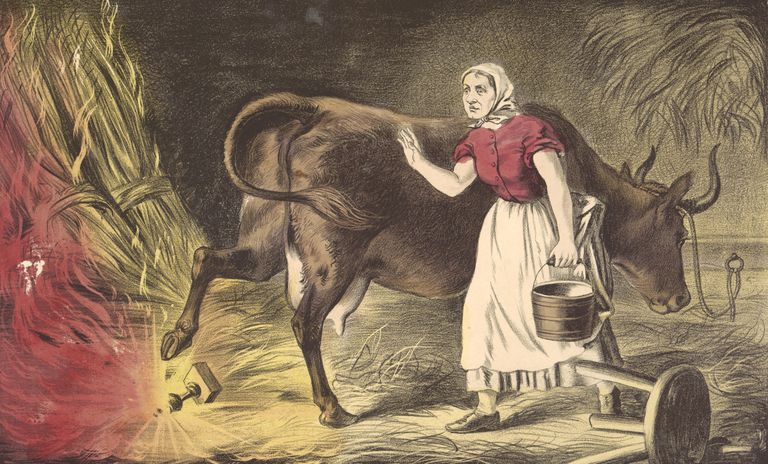
There is no doubt that most of us have heard the name, Old Mother O'Leary and maybe even sung the song about her a time or two. Legend has long held that a cow being milked by Mrs. Catherine O'Leary kicked over a kerosene lantern, igniting a barn fire that spread into the Great Chicago Fire.
The famous story of Mrs. O'Leary's cow appeared soon after a massive fire that consumed much of Chicago. And the story has spread ever since. But was the cow really the culprit? The real answer - No! The cause of the fire, which began on October 8, 1871, lies with a combination of dangerous conditions. Chicago saw a prolonged drought over a hot summer and loosely enforced fire codes. Add to that a city that was made primarily of wood, and you have a recipe for disaster. Yet Mrs. O'Leary and her cow took the blame in the public mind. And the legend about them being the cause of the fire endures to the present day.
The O'Leary Family
The O'Leary family, immigrants from Ireland, lived at 137 De Koven Street in Chicago. Mrs. O'Leary had a small dairy business, and she routinely milked cows in a barn behind the family's cottage. A fire did begin in O'Leary's barn at about 9:00 pm on Sunday, October 8, 1871. Catherine O'Leary and her husband Patrick, a Civil War veteran, claimed that they were in bed when they heard neighbors calling out about the fire in the barn. Somehow a rumor about a cow kicking over a lantern began spreading almost as soon as the first fire company responded to the blaze. Another rumor in the neighborhood was that a boarder in the O'Leary house, Dennis "Peg Leg" Sullivan, had slipped into the barn to have a few drinks with some of his friends. During this time, they started a fire in the hay by smoking pipes. It is also possible the fire ignited from an ember, which blew from a nearby chimney. The truth is that many fires did start that way in the 1800s. The difference this time was the conditions were present for the fire to spread quickly. No one will ever know what really happened that night in the O'Leary barn. What isn't disputed is that the blaze spread. And, assisted by strong winds, the barn fire turned into the Great Chicago Fire. Within a few days, a newspaper reporter, Michael Ahern, wrote an article that put the neighborhood rumor about Mrs. O'Leary's cow kicking over a kerosene lantern into print. The story took hold and was circulated widely.
The Official Report
An official commission investigating the fire heard testimony about Mrs. O'Leary and her cow in November 1871. An article in the New York Times on November 29, 1871, was headlined "Mrs. O'Leary's Cow." The article described the testimony given by Catherine O'Leary before the Chicago Board of Police and Fire Commissioners. In her account, she and her husband had been asleep when two men came to their house to alert them that their barn was on fire. Mrs. O'Leary's husband, Patrick, was also questioned. He testified that he did not know how the fire started and had been asleep until he heard the neighbors. The commission concluded in its official report that Mrs. O'Leary had not been in the barn when the fire began. The report did not state a precise cause of the fire but mentioned that a spark blown from a chimney of a nearby house on that windy night could have started the fire in the barn.
The O'Learys After the Fire
Despite being cleared in the official report, the O'Leary family became notorious. Oddly enough, their house actually survived the fire, as the flames spread outward away from the property. Yet, facing the stigma of the constant rumors, which had spread nationwide, they eventually moved from De Koven Street. Mrs. O'Leary lived out the rest of her life as a virtual recluse, only leaving her residence to attend daily mass. When she died in 1895, she was described as "heartbroken" that she was always blamed for causing so much destruction. Years after Mrs. O'Leary's death, Michael Ahern, the newspaper reporter who had first published the rumor, admitted that he and other reporters had made up the story. They believed it would hype the story as if a fire that destroyed a major American city needed any extra sensationalism.
The Legend Lives On
While the story of Mrs. O'Leary and her cow isn't true, the legendary tale still lives on. Lithographs of the scene were produced in the late 1800s. The legend of the cow and the lantern were the basis for popular songs over the years, and the story was even told in a major Hollywood movie produced in 1937, "In Old Chicago." The MGM film, which was produced by Daryl F. Zanuck, provided an entirely fictitious account of the O'Leary family and portrayed the story of the cow kicking over the lantern as the truth. The movie's popularity and the fact that it was nominated for an Academy Award for Best Picture helped perpetuate the legend of Mrs. O'Leary's cow. ResQ24 by Thompson Building Associates “Making it Right . . . Day and Night!” [email protected] 614-863-9650
